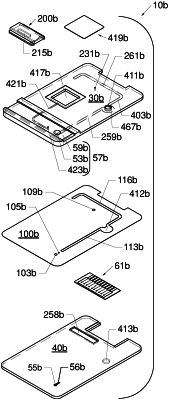| CPC G01N 33/492 (2013.01) [B01L 3/502715 (2013.01); G01N 21/255 (2013.01); G01N 21/33 (2013.01); B01L 2200/04 (2013.01); B01L 2200/16 (2013.01); B01L 2300/0654 (2013.01); G01N 2201/062 (2013.01); G01N 2201/08 (2013.01)] | 33 Claims |

|
1. A system for measuring at least a quantity of a first analyte and a quantity of a second analyte in a blood sample, the system comprising:
a removable cartridge comprising an optical chamber for receiving the blood sample,
the optical chamber comprising one or more optical windows for transmitting electromagnetic radiation (EMR) into and out of the optical chamber and the removable cartridge; and,
an analyzer comprising:
a housing;
a receptor in the housing for receiving the removable cartridge;
at least two EMR sources positioned in the housing to be aligned with an optical window of the one or more optical windows when the removable cartridge is received in the receptor, the at least two EMR sources being configured to emit different wavelengths of EMR into the receptor, and, when the removable cartridge is received in the receptor, to emit the different wavelengths of EMR into the optical chamber of the removable cartridge via that optical window, the at least two EMR sources being configured to provide
a first set of incident EMR into the optical chamber via that optical window of the one or more optical windows to interrogate the blood sample during a first time interval of a first duration, and
a second set of incident EMR into the optical chamber via that optical window of the one or more optical windows to interrogate the blood sample during a second time interval of a second duration;
an EMR dispersive element positioned in the housing to be aligned with EMR emerging from the optical chamber when the removable cartridge is received in the receptor and operable to disperse EMR emerging from the blood via an optical window of the one or more optical windows to produce
a first blood diffraction spectrum from a first set of emerging EMR emerging from the optical chamber, the first set of emerging EMR being generated by providing the first set of incident EMR to the optical chamber to interrogate the blood sample during the first time interval;
a first reference diffraction spectrum, wherein the first reference diffraction spectrum indicates intensities of the first set of incident EMR;
a second blood diffraction spectrum from a second set of emerging EMR emerging from the optical chamber, the second set of emerging EMR being generated by providing the second set of incident EMR to the optical chamber to interrogate the blood sample during the second time interval;
a second reference diffraction spectrum, wherein the second reference diffraction spectrum indicates intensities of the second set of incident EMR;
a one-dimensional multi-channel detector comprising an array of discrete detectors for measuring wavelength-specific dispersed emerging EMR;
and analog to digital converter for converting
the first blood diffraction spectrum into a first set of blood digital electrical signals to produce a first blood digital spectrum at a first wavelength range;
the first reference diffraction spectrum into a first set of reference digital electrical signals to produce a first reference digital spectrum at the first wavelength range;
the second blood diffraction spectrum into a second set of blood digital electrical signals to produce a second blood digital spectrum at a second wavelength range;
the second reference diffraction spectrum into a second set of reference digital electrical signals to produce a second reference digital spectrum at the second wavelength range;
wherein
each of the discrete detectors of the one-dimensional multi-channel detector having a saturation EMR intensity
wherein, increases in an intensity of an EMR signal received by each of the discrete detectors of the one-dimensional multi-channel detector beyond the saturation EMR intensity do not increase a digital signal derived by each of the discrete detectors of the one-dimensional multi-channel detector from that EMR signal, and,
a maximum EMR intensity in the first reference digital spectrum at a the specific wavelengths within the first wavelength range and a maximum EMR intensity in the second reference digital spectrum at the specific wavelengths within the second wavelength range exceed 10% of the saturation EMR intensity at the respective wavelengths;
at least one data processor for determining
the quantity of the first analyte based on at least a portion of the first blood digital spectrum at a first plurality of wavelengths within the first wavelength range and the first reference digital spectrum at the first plurality of wavelengths; and,
the quantity of the second analyte based on at least a portion of the second blood digital spectrum at a second plurality of wavelengths within the second wavelength range and the second reference digital spectrum at the second plurality of wavelengths.
|